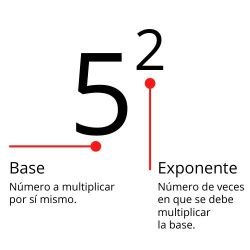What are the laws of exponents?
Laws of exponents
What are the laws of exponents?
The laws of exponents are the set of rules established to solve mathematical operations with powers.
The power or potentiation consists of the multiplication of a number by itself several times, and they are represented graphically as follows: xy.
The number that has to be multiplied by itself is called the base and the number of times by which it has to be multiplied is called the exponent, which is smaller and must be located to the right and above the base.
For example,

Now, in addition, subtraction, multiplication and division operations with one or more powers, how to proceed? The laws of exponents guide us to solve these operations in the simplest way possible. Let's see.
1) Zero power
1) Every number raised to 0 is equal to 1.
For example,
x 0 = 1
5 0 = 1
37 0 = 1
2) Power at 1
Every number raised to 1 is equal to itself.
For example,
x 1 = x
30 1 = 30
45 1 = 45
3) Multiplication of powers with the same base
The product of powers with identical base is equal to a power of equal base, raised to the sum of the exponents.
For example,
2 4 2 2 2 4 = 2 (4 + 2 + 4) = 2 10
4) Division of powers with the same base
When powers with the same base and different exponents are divided, the quotient is equal to another power with the same base raised to the sum of the exponents.
For example,
4 4 : 4 2 = 4 (4 - 2) = 4 2
5) Multiplication of powers with the same exponent
The product of two or more different powers with the same exponent is equal to the product of the bases raised to the same exponent.
For example:
3 2 2 2 3 2 = (3 2 3) 2 = 18 2
6) Division of powers with the same exponent
The quotient between two powers with different bases and the same exponent results in the quotient of the bases raised to the same exponent.
For example,
8 2 : 2 2 = (8: 2) 2 = 4 2
7) Power of a power
The power of a power results in another power with the same base raised to the product of the exponents.
For example:
(8 3 ) 3 = 8 (3 3) = 8 9
Update date: February 28, 2021.
Recommended content
60 qualities and defects of a personAbstraction: What is it, Characteristics, Types
Floods » What is it, Characteristics, Concepts
Histology: What is it, History, Methods, Branches
Narrative text: What is it, Characteristics, Types
Roman Law › What is it, Characteristics, Sources, Periods
Sources of law › What is it, Characteristics, Examples
10 Characteristics of Autism
10 Characteristics of Autocracy
10 Characteristics of Birds